Biologists worldwide may have to start re-evaluating their estimates of the number of species on Earth, since expeditions documenting the oceans’ tiniest species have revealed shocking diversity: in the tens of millions of species, at least, and according to one researcher “closer to a billion”.
Fourteen field projects sent out by the Census of Marine Life focused on the oceans’ smallest inhabitants: microbes, zooplankton, and tiny burrowing species inhabiting the deep sea bed. What they found was astounding.
Off the west coast of South America explorers discovered extensive mats of microbes: covering a surface the size of Greece, these microbe communities are one of the largest masses of life on Earth, and, according to researchers, resemble ecosystems from the Proterozoic period, between 2.5 billion and 650 million years ago.
 The acantharians are one of the four types of large amoebae that occur in marine open waters. Their fragile skeletons are made of a single crystal of strontium sulfate that quickly dissolves in the ocean water after the cell dies. Photo By: Dr. Linda Amaral Zettler. Copyright: image used under license to MBL (micro*scope). |
In all researchers estimate that marine microbes make-up 50 to 90 percent of the ocean’s entire biomass, weighing the equivalent of 240 billion African elephants. It is thought that there may be a billion individual microbes in one liter of seawater.
“In no other realm of ocean life has the magnitude of Census discovery been as extensive as in the world of microbes,” Mitch Sogin of the Marine Biological Laboratory in Woods Hole, Massachusetts and leader of the International Census of Marine Microbes (ICoMM), said in a press release. “Scientists are discovering and describing an astonishing new world of marine microbial diversity and abundance, distribution patterns and seasonal changes.”
To date, researchers have identified 20,000 marine microbe species, though estimates of bacteria alone range into the tens of millions.
However, “the total number of species of marine microbes, including both bacteria and archaea, based on molecular characterization, is likely closer to a billion,” says chair of ICoMM’s scientific advisory council, Dr. Baross, from the University of Washington.
“ICoMM has studied relatively few of the oceans’ microbial environments,” Baross explains, “and there are bacteria associated with each of hundreds of thousands of larger marine animals, all of which have a microbial flora in their guts and attached to their outer surfaces that have likely co-evolved with the animals. Marine animals alone may account for hundreds of millions of microbial species. This is a huge frontier for the next decade.”
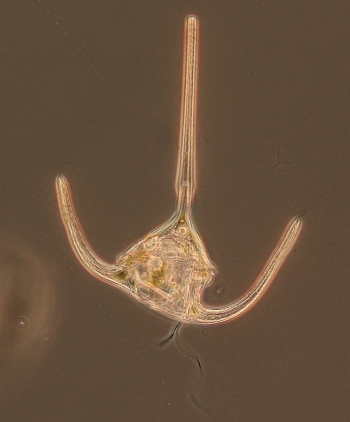 Ceratium longipes, a representative of a large and distinctive group of marine photosynthetic dinoflagellates adorns itself with three horns. Photo by: David Patterson, Linda Amaral Zettler, Mike Peglar and Tom Nerad, image used under license to MBL (micro*scope). |
To estimate diversity, researchers group microbes by genetic similarity.
“Tracking and visualizing such complex populations was impossible 10 years ago,” explains Baross. “Sequencing allows us to give the equivalent of an Internet URL to millions of microbes, to which we can attach all kinds of other information, like their favorite temperature and amount of salt and light.”
Scientists were surprised to find that so many of these newly discovered microbes were rare, sometimes less than one in 10,000 individuals. They speculate that these rare microbes are waiting for conditions to change, hoping to become abundant.
But what ecological role do the diversity and abundance of microbes play? A big one, according to researchers: microbes are responsible for more than 95 percent of the oceans’ respiration, where they turn atmospheric carbon dioxide back into carbon to be stored in ocean depths. For being incredibly small, marine microbes impact climate, recycle nutrients, decompose toxins, and help regulate the Earth’s atmosphere.
Researchers have also uncovered thousands of new species of zooplankton aided by genetic studies. According to Ann Bucklin, head of the University of Connecticut Marine Sciences Department, expeditions by the Census of Marine Life have likely doubled the number of described zooplankton from 7,000 known species that remain planktonic throughout their life (i.e. are not simply a larvae stage of a larger species) to 14,000.
Scientists also studied tiny worms, many smaller than one millimeter, which inhabit the ocean floor and crustacean-like copepods.
A square meter of the sea floor can contain over half a million roundworms, known as nematodes, but only a few of these roundworm species have been described by science.
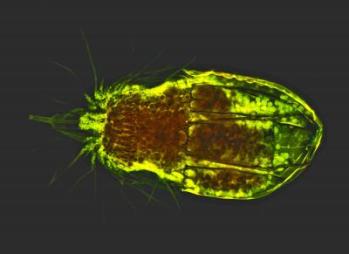 Census of Marine Life scientists with the German Center for Marine Biodiversity Research at the Senckenberg Research Institute, last year described this new species and genus of the burrower loriciferan, Culexiregiloricus trichiscalida, found at 4,141 meters (2.6 miles) depth in the Atlantic’s Guinea Basin south of Cote d’Ivoire, Africa, on the 2005 DIVA 2 expedition. Loriciferans, affectionately dubbed “girdle wearers” due to characteristic hind shells resembling a corset, are among the smallest known multi-cellular marine animals. This is a juvenile stage specimen with a body length is about 1/4 of a millimeter (1/100th of an inch) — roughly the width of three human hairs. The body is filled with granular cells and tissue. Photo by: Gunnar Gad, Marco Büntzow, Deutsches Zentrum für Marine Biodiversitätsforschung/German Centre for Marine Biodiversity Research, Senckenberg Research Institute, Germany /Census of Marine Life. |
Copepod diversity also surprised scientist: in two stops in the Atlantic Angola Basin, researchers discovered 700 unique copepod species—nearly all of which were unknown to science—in just 5.4 square meters. The new copepod species nearly doubles the number of copepod species known in the southern hemisphere.
“Far from being a lifeless desert, the deep sea rivals such highly diverse ecosystems as tropical rainforests and coral reefs,” says Census of the Diversity of Abyssal Marine Life leader Pedro Martinez Arbizu. “As tiny burrowers crawl around they help oxygenate sediments and interact with microbes to cycle nutrients and carbon on the ocean floor. Once again, the tiny play a mighty role.”
“The inventory of life in the deep sea has only just begun, and much more remains to be done,” he adds. “Sediment-covered seafloors cover more than 60 percent of Earth’s surface. And, given these new insights, we cannot possibly use the deep-sea floor as a waste dump or subject it to unlimited resource extraction without massively impacting the marine communities living there.”
While copepods and zooplankton are not as diverse as microbes, the variety of marine viruses may rival that even of microbes.
“The first census of marine viruses should be a goal of the next decade,” Baross says. Biologists still debate whether or not viruses should be considered ‘species’ in their own right, since some do not consider viruses properly alive.
Wherever oceanic research goes from here, it is clear the Census of Marine Life has once again uncovered unexpected wonders across our blue planet.
As Ian Poiner, scientific chair of the Census says: “the Census of Marine Life takes immense pride in recognizing the hidden majority.”
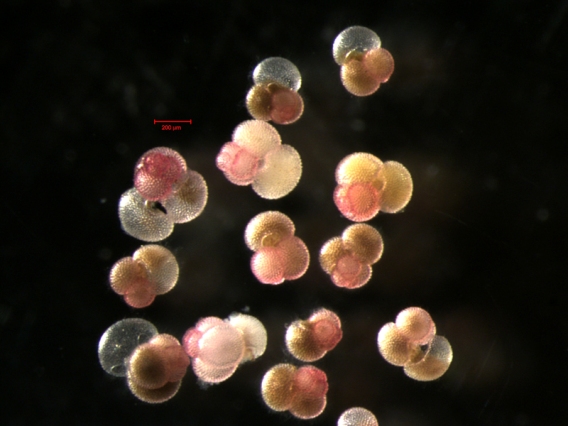
These pink bubbles are live planktonic foraminifera from the Sargasso Sea, a group of single-celled animals that produce multi-chambered tests to protect their jelly-like bodies. The red line is 200 microns; the forams are about 1/2 millimeter in diameter. Photo By: Colomban de Vargas, EPPO/SBRoscoff.
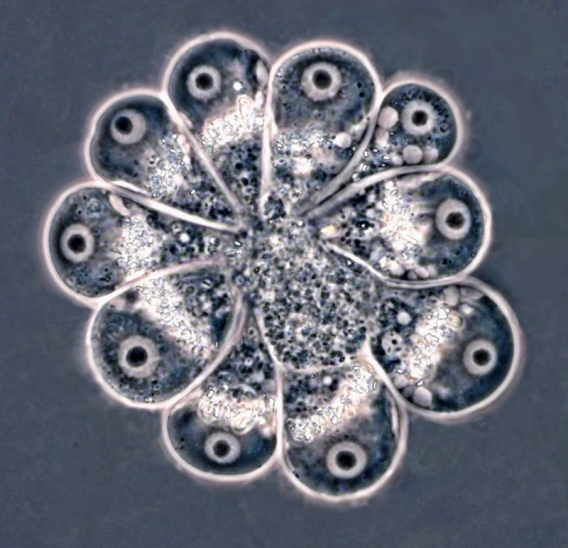
Chlamydophrys, a little reported amoeba inside a house called a test, usually has one large nucleus and forms clusters as in this group of 10. Photo By: D. J. Patterson, L Amaral-Zettler, M. Peglar and T. Nerad, under license to MBL (micro*scope).
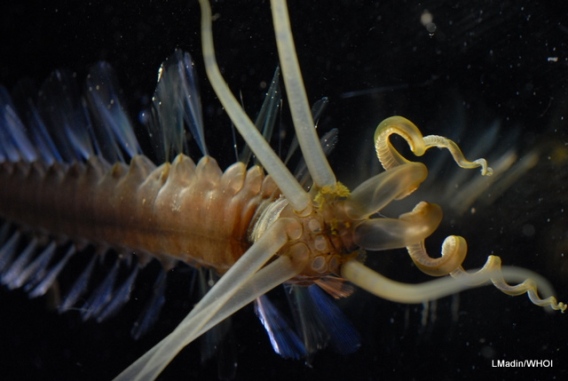
The ‘squidworm’ was collected in the Celebes Sea, at about 2800 m depth, using the “Global Explorer” ROV in September 2007. It is considered a new genus and species, in a newly described family of swimming polychaetes (Osborn et al. 2009, Science 325:964). Photo by L. P. Madin, Woods Hole Oceanographic Institution.
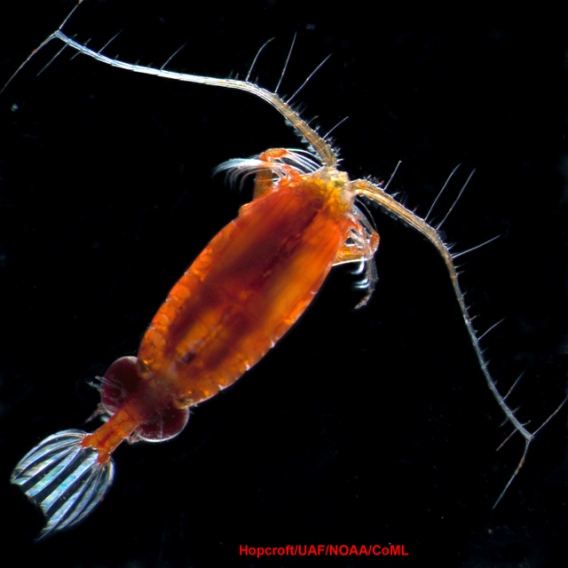
Valdiviella insignis is a copepod. This crustacean lives very deep, over 1000 meters. Photo shows a female with purple egg sacs. Photo by R. Hopcroft, University of Alaska – Fairbanks (UAF).
Related articles
Videos and Photos: over 17,000 species discovered in waters beyond the sun’s reach
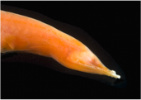
(11/23/2009) Deep, deep below the ocean’s surface, in a world of ever-present darkness, one would expect few, if any, species would thrive. However, recent expeditions by the Census of Marine Life (CoML) have found an incredible array of strange, diverse, and amazing creatures. To date a total of 17,650 species are now known to live in frigid, nearly lightless waters beyond the photic zone—where enough light occurs for photosynthesis—approximately 200 meters deep. Nearly 6,000 of these occur in even harsher ecosystems, below depths of 1,000 meters or 0.62 miles down.
Video: no sunlight, no food, frozen conditions, but NASA finds complex life
(03/16/2010) In a discovery at the bottom of the world that could have implications on the search for extraterrestrial life, researchers were astounded to find an amphipod swimming beneath a massive Antarctic ice sheet.
Newly discovered deep sea worms throw bioluminescent ‘bombs’

(08/20/2009) Researchers from Scripps Institution of Oceanography at UC San Diego have announced in Science the discovery of seven new species of deep sea worms, five of which drop orb-like parts of their body which cause a brilliant green display of bioluminescence. For this reason researchers have nicknamed them the ‘green bombers’. The worms are not just new species, but a clade of animals entirely unknown to science until now.
Photos: 13,000 species found in Arctic, Antarctic Oceans

(02/16/2009) A marine census has documented more than 13,000 species in the Arctic and Antarctic Oceans, including several hundred that may be new to science. Conducted over a two-year period under often perilous conditions — including monster waves and dangerous polar bears — the series of 18 surveys turned up a wealth of information on the diversity, distribution and abundance of marine life. The research will also help establish a baseline for measure changes in polar ecosystems.
First footage captured of giant sea serpent of the deep: the oarfish
(02/09/2010) Scientists have captured what they believe to be the first footage ever of the oarfish, the species likely responsible for legends told of sea serpents.
Photos: Gelatinous Blobfish in danger
(01/26/2010) A species dubbed “the world’s most miserable-looking fish” is at risk of extinction due to poor fishing practices, reports The Daily Telegraph.
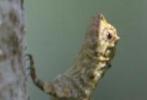
(01/13/2010) A number of media outlets are reporting a new type of depression: you could call it the Avatar blues. Some people seeing the new blockbuster film report becoming depressed afterwards because the world of Avatar, sporting six-legged creatures, flying lizards, and glowing organisms, is not real. Yet, to director James Cameron’s credit, the alien world of Pandora is based on our own biological paradise—Earth. The wonders of Avatar are all around us, you just have to know where to look.
Bottom-dwelling sea animals play surprising role in carbon sequestration
(01/07/2010) Researchers have long known that some marine animals, such as plankton, play big roles in the carbon cycle, but a new study shows that a long-ignored family of marine animals, the bottom-dwelling echinoderms, also do their part in the carbon cycle.
EBay bid to name new shrimp species raises $2,900 for conservation from NBA star
(12/07/2009) Former NBA basketball player for the Chicago Bulls, Luc Longley, has won the EBay auction to name a wild looking red-polka dotted shrimp species. Longley won with a bid of 3,600 Australian dollars (2,900 US dollars): all of the funds go to the Australian Marine Conservation Society (AMCS). He named the shrimp Lebbeus clarehanna as a gift for his daughter, Clare Hanna Longley’s fifteenth birthday.
Photos: new deep sea species discovered off the Canary Islands

(09/21/2009) Owned by Spain, but located just off the northwest coast of Africa, the Canary Islands sport a wide variety of marine life, including five species of marine turtles, ten species of sharks and rays, and innumerable fish and invertebrates. However, a new expedition has gone beyond the known, sending a robot to depths of 500 meters to discover the secrets of the Canary Island’s deep sea.
Extremophiles discovered below Antarctic glacier are remnants of marine life
(04/16/2009) Living in isolation for millions of years, cut off from sunlight and oxygen, surviving by breathing iron beneath an Antarctic glacier—such are the conditions of newly-discovered microbes living under Taylor Glacier in Antarctica’s desert-waste, the McMurdo Dry Valleys.